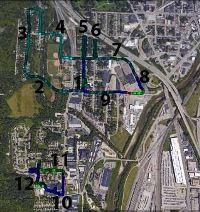Health Impacts of Microenvironments in the Summer

While socioeconomic factors are commonly associated with health disparities, the role of the outdoor environment, especially during extreme heat events, has been less frequently studied.
This research investigates the heat stress index (HSI) and ultrafine particle (UFP) exposure in 24 microenvironments. The data were recorded during an extreme heat event in 2016; the goal was to better understand how residents experience environmental exposure as a part of their daily routine when the boundaries between microenvironments are repeatedly crossed. Additionally, a statistical analysis of such exposure along both spatial and temporal scales is presented here, in order to assess the dual roles of development patterns and overlapping loci of social interactions within these microenvironments.
The results of this study show that HSI and UFP exposure varies in space and time. The HSI in 54% of the microenvironments tested was within the danger zone identified by the National Weather Service (104ºF to 124ºF), while the remaining 46% of the microenvironments fell within the extreme caution zone (91ºF to 103ºF). The average five minute walk among these microenvironments indicated that 70% of the time residents would be subjected to a danger zone, and the remaining 30% of the time they would fall within extreme caution conditions. The average UFP exposure varied from 7,633 to 34,751 particles/cm3. Microenvironments with a high percentage of sealant surfaces and lack of vegetation showed increased HSI values; close proximity to traffic and the freeway further elevated HSI and UFP exposure.
These results are useful in understanding the health outcomes previously recorded by a community health survey in which heat and respiratory illnesses were substantial. The evidence presented here provides crucial context-specific information for re/designing urban communities to minimize health disparities.
keywords: microenvironment, development pattern, heat stress index, ultrafine particle exposure, low-income communities


Add comment
Log in to post comments